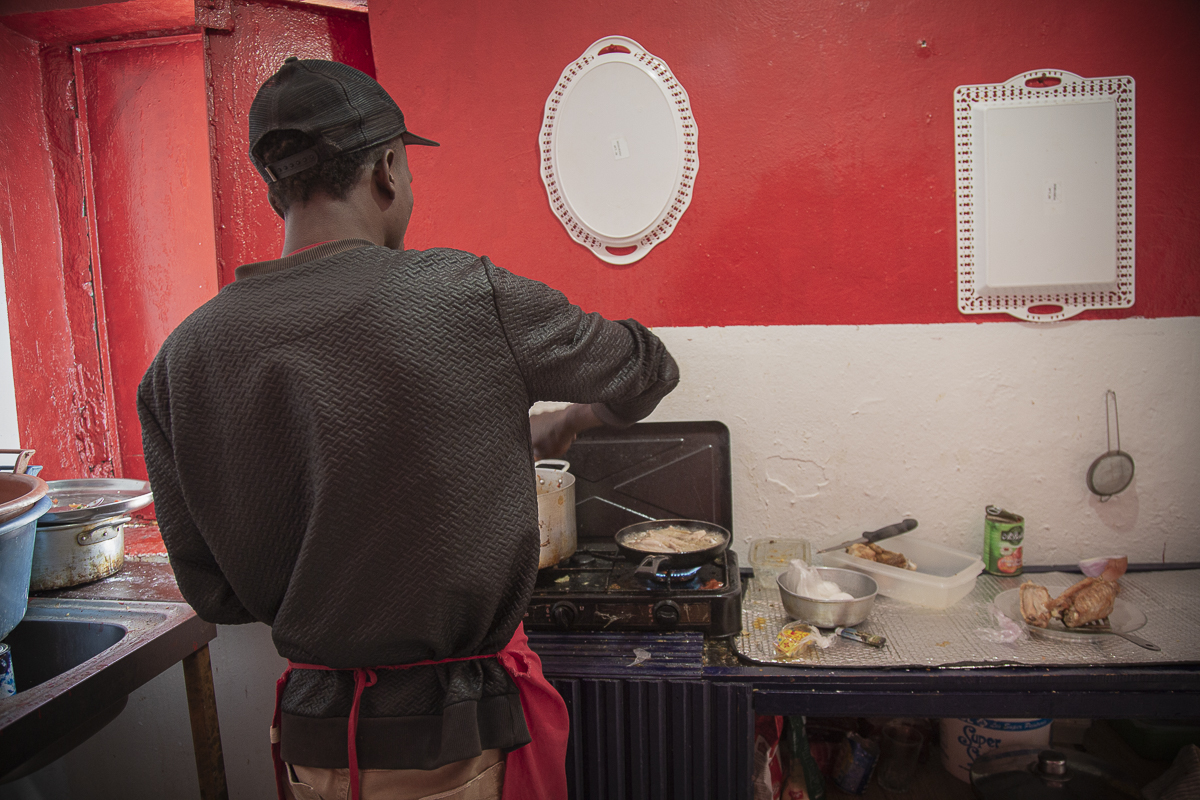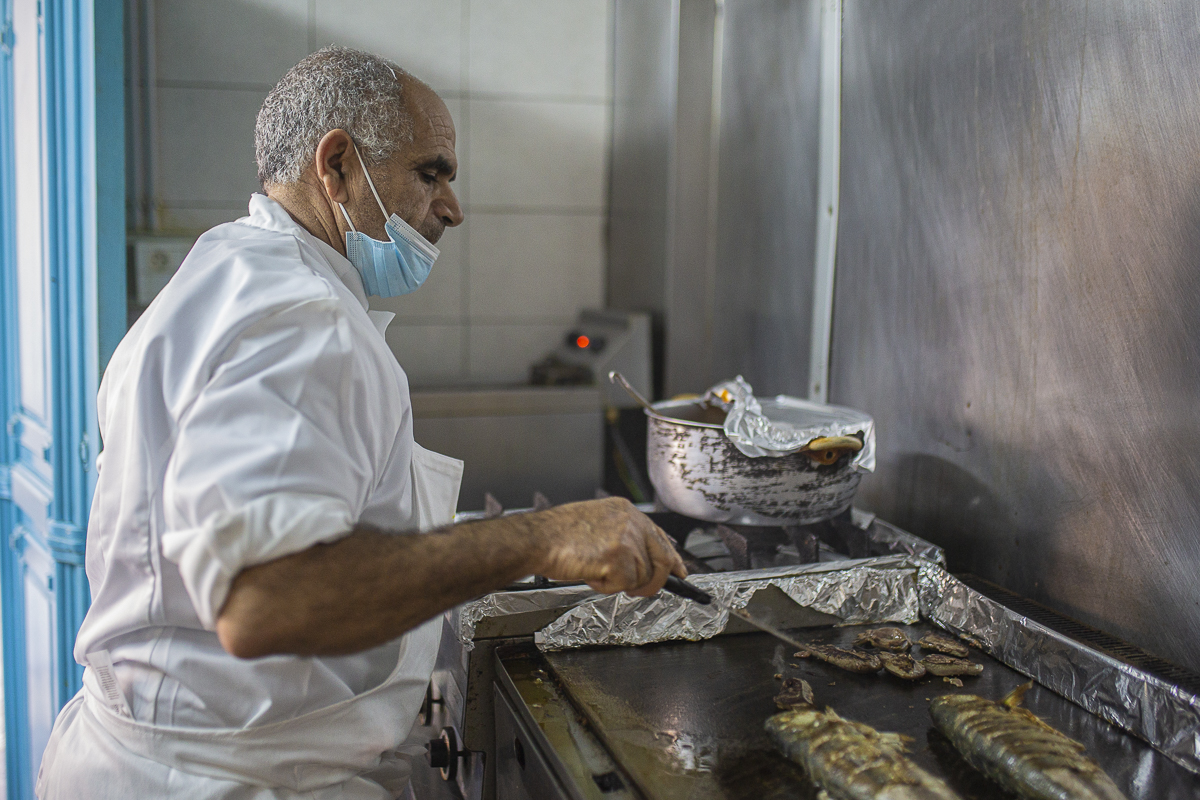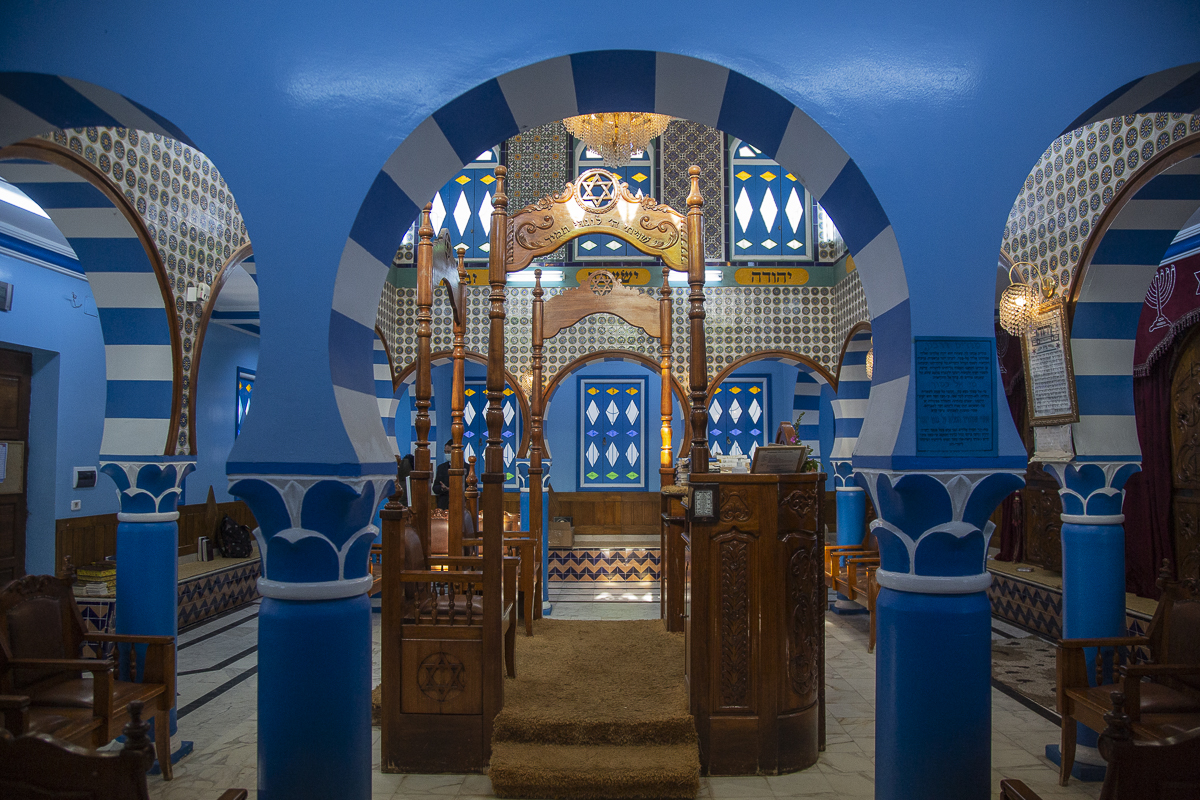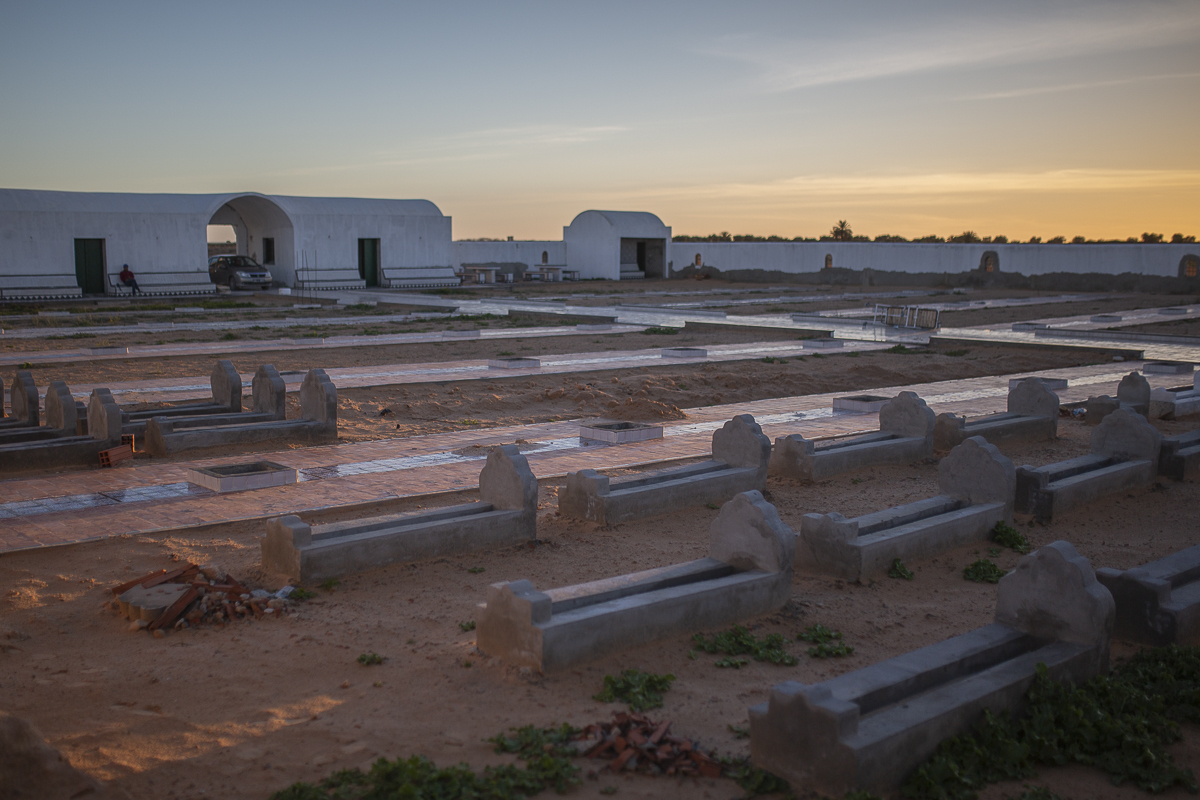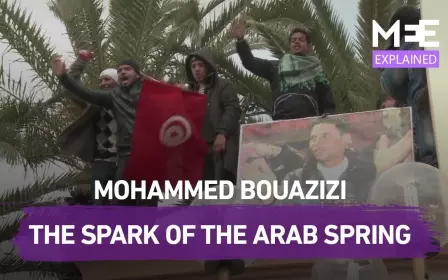Inside Zarzis: The quiet fishing port at the crossroads of Tunisian culture

Inside the Zarzis African Kitchen Restaurant, owner Samuel Diamond moves with plates in hand between the kitchen at the back and the plastic tables in front, chatting rapidly with two customers in Nigerian Pidgin English.
A former journalist, Diamond, 30, is the founder, owner and chef of the eatery, and a migrant from Nigeria who - hoping to escape persecution over his reporting - fled his home country in 2016.
After moving north through Africa and ending up in Libya, he spent two years in the conflict-stricken country before he escaped to Tunisia through the desert in 2018.
Diamond realised Tunisians wouldn't employ him without official papers, so he decided to move on with his life by starting his own business. In December 2019 he opened African Kitchen, which he operates by himself. Nigerian fried rice and hearty vegetable soup are his specialities.
Most of the customers are other migrants or refugees from sub-Saharan Africa. And despite the cultural mixture in Zarzis, there’s often limited contact between locals and migrants from outside Tunisia.
Nevertheless, Diamond said that he occasionally gets Tunisians visiting to ask for special dishes: “But they have to be those Tunisians who have travelled around Africa and know some dishes."
Existing in the shadow of the better known and nearby tourist hotspot of Djerba, Zarzis is a town of some 75,000 people that is rich in culture, boasting crumbling French colonial architecture, a colonial-era church-turned-museum, the old Jewish Hara neighbourhood, a giant military base, and tranquil farm houses, among so much else.
Outside Diamond's restaurant, a beachside hotel blocks away - largely dormant in the winter - plays host to handfuls of European package tourists; while down the street, locals bustle about jewellery shops in a tiny neighbourhood in Zarzis’ centre that is home to a small number of Tunisian Jews.
As well as the Jewish community, Zarzis hosts a large proportion of black Tunisians, local migrants to Europe who’ve returned to flaunt their wealth, a hardy fisherman’s culture and European tourists seeking a cheap vacation as well as retirees settling in permanently.
There are also ever-increasing numbers of sub-Saharan migrants who left Libya’s shores towards Europe, only to find their boats sinking and being towed into the port in Zarzis.
Further on, the last major port before the Libyan border is filled with sunburnt fishermen and coastguard patrol boats. At night, from the beaches nearby, Tunisians set off clandestinely for the Italian island of Lampedusa. They are called harraga, a Maghrebi Arabic word used to describe North African migrants who flee to Europe in search of a better life. The word literally means 'those who burn'.
Spice of Zarzis
About four kilometres down the street from Diamond’s restaurant, in the centre of Zarzis, there’s Lasaad Nawaili, a wizened 59-year-old town native, and his Restaurant Le Grand Bleu. After working decades in restaurants in Europe - nine of those years undocumented - he came home to open Le Grand Bleu in 2004.
His speciality is grilled wolf fish, cuttlefish, and seafood platters. He buys and hauls the fish fresh from the port daily, seasoning it with salt, cumin, turmeric and olive oil from the vast olive orchards outside town for which Zarzis is well-known.
And as for the harissa, the famous spicy Tunisian red pepper sauce that accompanies each dish, Nawaili only uses homemade, noting an unusual Zarzis harissa tradition.
Pointing to a rack of spices and a bowl of harissa in olive oil beside plates of freshly grilled fish he served up for Middle East Eye, he said, “In Zarzis, the man doesn’t buy harissa from outside. The woman makes spices - buckets of them to supply the whole year. It’s a woman’s craft.”
But he noted that since the outbreak of the coronavirus epidemic in March and the health measures imposed, including a curfew, he’s lost 70 percent of his business. One of the few things keeping him afloat, he said, are the ferries that come in summer full of returning Zarzisans - called ‘akkara’ after an old tribal name for local people - now coming directly from Europe into Zarzis’ recently renovated commercial port, ready to spend money.
“They miss this food,” Nawaili said.
The Hara
Only a few blocks from Nawaili and his restaurant is the Hara, the tiny Jewish neighbourhood at the centre of Zarzis. The neighbourhood is home to more than half a dozen small synagogues. The Hara is framed by arches over each of its small streets.
David Boukhris, 52, a Jewish Tunisian from Zarzis, spoke with Middle East Eye rapidly in the distinct Tunisian Arabic accent of Zarzis, as he drove up to the door of his apartment, just outside the arch which marks one entryway into the Hara.
He points out a primary school just inside the walls of the Hara.
“All the children study here - Muslims, Jews. Families from outside the Hara send their children here because it’s got such a good reputation. After all, it receives donations from everybody. I’ve got a construction materials company, so whenever they need maintenance, I help.”
In the Hara, which Boukhris said is home to around 110 Jewish inhabitants - out of a total of around 2,000 Jews across Tunisia - shops selling gold jewellery stretch down one street. Gold and silver dealing are a speciality of the neighbourhood.
Inside one such shop, a trader named Mabrouk from Ben Guardane, a town southeast of Zarzis close to the border with Libya, negotiates rapidly with the shop owner over some jewellery to bring to the border. Traders like him are eager to get back to business in a part of Tunisia that is deeply economically deprived, especially after nine months of a border closure with Libya due to anti-coronavirus measures.
Boukhris took Middle East Eye to one of Zarzis’ synagogues and religious schools. Inside, coronavirus notices pasted on walls remind worshippers to wear masks at all times, and to maintain social distancing. The notices use Hebrew letters to write Tunisian Arabic. It’s an oddity in a place where Tunisian Arabic is rarely used for written communication, and often in Latin characters. Classrooms around a courtyard are filled with benches, books and prayer scarves for boys to study the Torah in the gender-segregated school. The largest space, the prayer hall, is illuminated with a huge chandelier and coloured glass windows over arches of ornate tile work.
Despite Tunisia’s small Jewish population, Boukhris is confident of the Jewish community’s place here, and proud.
“It’s the politicians that make all the problems. But in Zarzis it’s very beautiful. There’s tolerance, and the people here are open to each other. And in my company, when the workers here talk with others, they say, ‘My boss is Jewish.’ They’re proud of that.”
It’s not only Judaism that has a presence in Zarzis, but Christianity as well. A few minutes’ walk from the Hara is the church of Notre Dame de la Garde, built in the early twentieth century by the French colonial authorities. Now a museum, it carries artefacts pulled from around the peninsula of Zarzis, dating back to its Arab, Roman and Phoenician periods, and beyond.
While Notre Dame de la Garde church no longer serves the colonial Christian population that it once did, a new wave of Christians is settling in. Retired Europeans are taking up residence in Zarzis for its sun, sea and inexpensive, quiet lifestyle.
Race
Zarzis is also home to a large number of black Tunisians, who constitute between 10 and 15 percent of Tunisia's population. The country has struggled with racism, as much towards sub-Saharan migrants as its own black population. Popular perceptions in Tunisia, however, are that racism in southern Tunisia is even harsher, with strong resistance to interracial marriages, and even cases of school buses, graveyards, and whole villages segregated by colour.
Plumber and electrician Toumi Ben Taleb is a black Tunisian. He was raised in Hassi Jerbi, a village of gardened villas and farmhouses spread along emerald waters some 20 minutes’ drive north of Zarzis.
“You could say I’m lucky to have been born in Hassi Jerbi, and to live here today. Here people are more honest than in Zarzis,” Ben Taleb said, even though Hassi Jerbi could easily be considered a rural extension of Zarzis.
Ben Taleb admits that people have used racist language with him, calling him wasif, a term meaning something close to “slave”.
But, he said, “Maybe they call me that because of my simple work, my status in the village.”
Ben Taleb notes southern Tunisia’s long history of tribal society, largely broken up after independence by the late president Habib Bourguiba. In that society, some tribes dominated others, and used dark-skinned slaves to work their lands.
“That’s why the one who says wasif is backwards. He’s carrying on the thinking of his grandfathers.”
Fishing waters
A 15-minute walk from downtown Zarzis is the port, where large fishing boats rise and fall slightly on their moorings, and men sit on the dock repairing nets. Zarzis is the largest fishing port in southeast Tunisia, and along with the better-known island of Djerba immediately to the north, they carry a deep-rooted fishing culture.
“The fishing culture goes back to the time of our grandfathers,” said Slah Eddine Mcharek, president of the Zarzis Fishermen’s Association. “Fishing traditionally, with nets, cages, longlines."
Zarzis’ waters have historically brought fishermen from far and wide.
“Our grandfathers used to work with the Italians, Maltese, and fishermen came over from Tripoli [in Libya],” he said, noting that in recent years, due to the instability in Libya and strict conventions with the EU, the nautical border with Libya is now a heavily-policed no-go zone.
Yet the most unique things harvested in the waters around Zarzis are sea sponges, a rarity found only here and in the waters of Mahdia, further north on the coast.
Samir Khenisi, a sea sponge diver who’s been fishing Zarzis’ waters in a 14-metre-long boat for decades, told Middle East Eye: “Sponge fishing is a true craft. We learned it from our fathers, who learned it from the Greeks.”
Fishing boats from Greece have plied the coasts of Tunisia for centuries, fishing sponges. Now, Khenisi said, it’s Greek businessmen who come to Zarzis to buy sponges.
“When the sponge fishing season wraps up, the Greeks call us and tell us when they’ll come to buy our sponges. They know that the ones we fish in the waters here are the best quality.”
‘The garden of Africa’
Zarzis’ fishermen have also become known in recent years for saving migrants at sea leaving Libya towards Europe. However, they also end up bringing in the bodies of those that have perished at sea making the journey. Between 2014 and 2019, more than 19,000 migrants died crossing the Mediterranean.
Saving those stranded at sea forms part of the curriculum at Zarzis’ Fishing School, where local fishermen like Khenisi were trained.
Driving south out of Zarzis, one comes upon the Zarzis stadium. On a dirt road about a kilometre behind the stadium, amid fields patched with orchards, is Zarzis’ newly built migrant cemetery.
Cared for by a local pharmacist and humanitarian, Mongi Slim, the cemetery is a reminder of Zarzis’ darker side as a crossroads of peoples - drowned migrants from sub-Saharan Africa, Syria and as far away as Bangladesh, who left Libya’s shores towards Europe. Its 457 pre-dug graves awaiting new bodies are neatly lined up within the cemetery’s walls, covered over with a marble slab and a dusting of earth.
“We used to use the old municipal cemetery for the bodies, which was in terrible shape,” said Slim, sitting by a multi-faith prayer space in the cemetery as the sun was setting. “We couldn’t stand the thought of bodies being dumped into mass graves, and we wanted to be able to identify bodies by DNA.”
So in 2019 Slim and his associates began crowdfunding to build the cemetery. A wealthy Algerian businessman in France, whose brother died crossing the Mediterranean to Europe, learned about the project and funded the rest.
“Whoever [these people] were, just yesterday they had dreams to make money and send it to their families, and now they’re in a place they never imagined - a grave,” Slim said.
He said that there’s talk of the cemetery being classed as an international heritage site by UNESCO. He has plans to plant trees and build a small museum in the cemetery to show visitors to Zarzis the things migrants left behind.
“We’re going to call it ‘Le Jardin d’Afrique - The Garden of Africa,” Slim said. “A place for the migrants brought from the sea to be buried with respect.”
Middle East Eye propose une couverture et une analyse indépendantes et incomparables du Moyen-Orient, de l’Afrique du Nord et d’autres régions du monde. Pour en savoir plus sur la reprise de ce contenu et les frais qui s’appliquent, veuillez remplir ce formulaire [en anglais]. Pour en savoir plus sur MEE, cliquez ici [en anglais].


